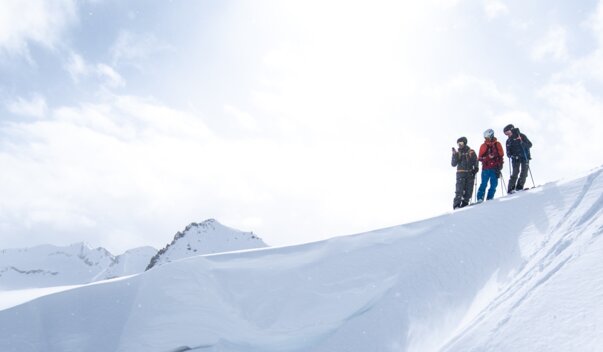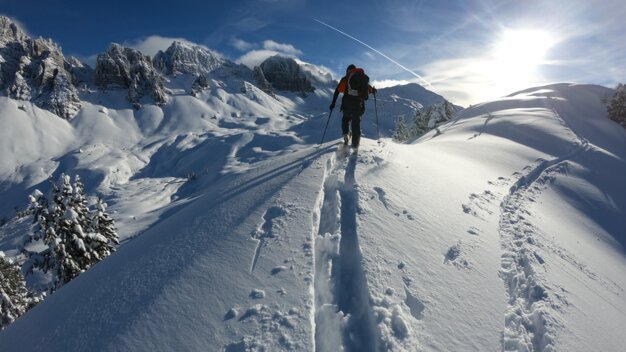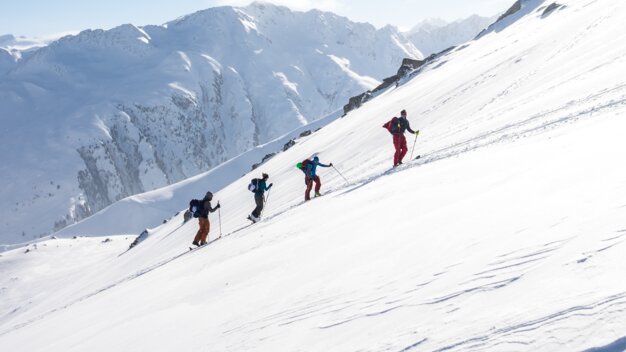
Experienced ski tourers agree: Crampons are indispensable on every ski tour, especially in spring. Comparable to boot crampons for mountaineers, ski crampons give ski tourers more stability and safety. In some cases, they might save the day – in others, maybe even your life.
The use of crampons is uncharted territory for you? No worries! We have summarised the most important information about these often-underestimated traction devices.
What are ski crampons?
Crampons are claw-like metal pieces made of aluminium or lightweight steel that attach to the bindings of your touring skis. Their pointed prongs bite into the snow when you step down, so that your skis can no longer slip away. A tool that can make skinning slopes on icy sections and on hard crust much easier!
When do I need crampons on a ski tour?
In hard crusted snow, your touring skis might slip away as you go uphill, despite the use of skins. With the right technique, you can compensate for a lack of traction in flatter sections. In steep terrain, however, that’s often no longer possible.
Safety tip: Icy slopes are particularly common in spring, usually after clear and cold nights when there’s been a deep overnight freeze. A hard layer of snow is a sign of low avalanche danger but be warned: When it is warm throughout the day, the snow can lose its stability and you might break through the snow cover. You will notice this at the latest when you suddenly sink deep into the snow – and that’s a sign of increased avalanche danger!
So the earlier in the day you set off on a ski tour in spring, the lower the likelihood of avalanches. Learn how to read an avalanche report now!
How do crampons work?
The teeth of the crampons bite into the hard snow as you put pressure on the bindings. This prevents you from slipping sideways when you kick-turn or traverse steep passages. What’s more, it keeps you from sliding backwards as you skin uphill on steeper sections – thus avoiding potential falls. However, crampons are only useful if they are put on correctly.
How do I put on crampons?
With ski crampons, it's not only important how you put them on, but also when. That's because you need to take off your skis completely or, at least, partially – and that’s difficult to impossible in steep terrain. So remember: Put on your crampons in good time, before the terrain gets too steep!
Tip: Before you head out on your ski tour, try to find out exactly what the conditions are on the planned route. To ensure that you have no problems putting on your crampons when you need them, we recommend you practice the process at home. You should also check whether the crampons fit with your touring skis and are compatible with the bindings. The crampons are usually a few millimetres wider than the skis.
Putting on crampons: Here’s how it's done!
- Take one boot out of its binding completely. Alternatively, you can also lean forward, unweight the target ski, and lift your heel. The latter takes a bit more practice and flexibility.
- Slide the crampon into position.
- Now you can put the ski back on.
Good to know: Wearing crampons might feel strange at first, because the skis don't glide as well, but you’ll get used to that quickly.
Can I use crampons and climbing aids at the same time?
Yes, but only if the climbing aid or heel riser is used at its lowest level. Why? The more heel riser you employ, the less traction you’ll get. Your crampons will no longer be fully engaged because the teeth can no longer dig into the ground properly.
We recommend: Take out the climbing aid if you want to use crampons.
When should I rather not use crampons?
In some snow conditions, the use of crampons is not advisable. On bare ice, for instance, boot crampons are the better choice. If you are planning a glacier tour, you should always have boot crampons in your backpack. If the snow cover is thin and fading, it is better not to use crampons either – simply because they can be damaged by exposed rocks.
What else should be considered when using crampons?
- The right skinning technique: Proper form and the right technique are crucial for crampons to have the desired effect.
- The choice of track: Choose a track that’s as flat as possible. This way, crampons can optimally counteract lateral slipping and sliding.
INTERSPORT Rent Tip
You’re standing below a section of hard-packed snow, but you left your crampons at home? Then change your route or turn around and head back! The alternative is to put your skis on your back and continue on foot – but that quickly becomes exhausting and only makes sense for short stretches of the route. To avoid this situation, we recommend:
- Always have your crampons with you on ski tours in spring.
- Plan each tour carefully and find out about the snow conditions along the route.







